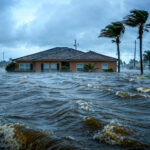Power networks, pipelines, radio communications and the global positioning system (GPS) are all entering a period of increased risk of outages from geomagnetic storms as the solar activity cycle peaks in 2013.
So far the increase in solar activity has been smaller than expected.
Nevertheless, there is no reason for complacency. Major geomagnetic storms are more frequent during the periods of maximum solar activity that occur every 11 years but can occur at any time, sometimes with serious results. Grid operators might have just 30 minutes notice of an incoming storm to take emergency action.
The U.S. National Oceanic and Atmospheric Administration’s (NOAA) Space Weather Prediction Center (SWPC) in Boulder, Colo., classifies storms on a five-point scale.
Minor (G1) and moderate (G2) storms are relatively common, occurring on about 1,200 days out of every 11-year cycle, but are barely perceptible. Most cause only small voltage fluctuations in power grids and faded signals on high-frequency radio networks. For a lucky few, the northern lights (aurora borealis) may be visible as far south as Idaho and New York.
Severe (G4) and extreme (G5) storms are less frequent, occurring on just 60 and four days, respectively, in every 11 years but do much worse damage.
In an extreme storm, power systems experience widespread voltage control problems, with the risk of blackouts or complete collapse. Electric currents reaching hundreds of amperes surge through pipelines. Satellite navigation may degrade or be unavailable for days at a time, and the aurora is visible in Florida and Texas, according to NOAA.
In March 1989, an extreme geomagnetic storm blacked out the whole of Hydro-Quebec’s power network in less than 90 seconds, wiping out power to 6 million people for up to nine hours.
A series of geomagnetic squalls in late October and early November 2003, known as the Halloween storm, knocked out two transformers in southern England, a transformer in South Africa, and caused blackouts in Sweden. Aircraft had to be rerouted away from polar latitudes, and astronauts on the International Space Station were ordered to take shelter as a precaution.
Far worse storms have occurred in the past. A massive storm in 1921 halted telegraph service throughout the eastern United States. If it were repeated today, it would leave 130 million people without power and permanently damage 350 hard-to-replace transformers, according to one estimate cited by the U.S. National Research Council (“Severe Space Weather Events: Understanding Societal and Economic Impacts” 2008).
The biggest storm of all occurred in 1859. Known as the Carrington Event, it was really two massive blasts on Aug. 28 and Sept. 2. The northern lights were visible as far south as Panama, so strong that they lit up the night sky as if it were day in the Rockies and New York.
The Carrington Event took down the infant telegraph service across North America, but power grids and radio broadcasting did not yet exist, so its impact was limited. In today’s fully electrified society, dependent on mass communication and GPS, the same storm would bring the economy to a standstill.
Early Warning System
Geomagnetic storms are triggered when a billion tonnes or more of solar plasma erupts from the surface of the sun at speeds of up to 3,000 kilometers per second, in what is known as a coronal mass ejection (CME).
If the mass ejection occurs in the direction of Earth, it can interact with the planet’s own magnetic field and induce a substantial voltage on the surface. Long man-made conducting paths such as transmission lines, metallic pipelines, cables and railways act as antennae, focusing and transferring the current.
NOAA’s Space Weather Prediction Center and Canada’s Space Weather Forecast Center both monitor CMEs and issue advisories about geomagnetic storms through a series of short-term forecasts as well as alerts and warnings in real time. Among the main customers are electricity transmission companies.
But CMEs are difficult to predict. They often batter Earth about four to five days after a solar flare is observed, but not always. The Advanced Composition Explorer (ACE) satellite, stationed a million miles from Earth, can detect the intensity of an incoming storm but may give as little as 30 minutes warning of its arrival. Forecasters issue a Sudden Impulse Warning, which indicates the Earth’s magnetic field will soon be distorted by an incoming geomagnetic disturbance.
Demand for solar weather predictions and warnings has grown rapidly from operators of power, communications and navigation systems and airlines, but the crucial ACE satellite is aging and nearing the end of its useful life.
Network Perils
Geomagnetic storms can damage the power grid in two ways. The more likely (but less serious) problem is when a storm destabilizes voltage across the network, causing relays and generating units to shut down as a precaution to prevent further damage to the grid. This is essentially what happened in Quebec and southern England.
The mass blackout across the Northeast United States and into Canada in August 2003, which left 50 million people without electricity for up to four days, was caused by tree growth tangling with power lines rather than geomagnetic storms. Nevertheless, it demonstrates how such a problem in one part of the network can cascade across the grid if not controlled properly.
Provided no serious physical damage is done, the network can be restarted in a matter of hours or days. All grids have procedures for a “black start” following complete collapse: first by starting up specialist diesel generators, re-energizing selected power plants, connecting them to the grid, then gradually bringing the rest of the power generating sets back online and gradually restoring power to customers one area at a time.
Less likely (but much more damaging) would be if a storm caused some of the extra-high voltage (EHV) transformers on the network to overheat and burn out. Most networks have only limited supplies of EHV transformer components, and there would be long lead-times for designing, manufacturing and installing new ones.
If a large number of transformers were fried, it might take months to restore power, according to a report on the “Effects of Geomagnetic Disturbances on the Bulk Power System” published by the North American Electric Reliability Corporation (NERC) in February 2012.
Bracing For The Big One
Risks to the network and transformers are heightened when power lines and transformers are operating close to capacity. The biggest danger comes in spring and autumn, when a relatively small number of power plants are operating and transmission is in high demand.
The simplest way to safeguard the network is to cut the demand for transmission, which lowers the operating temperature of the transformers so they have more room to rise safely without causing permanent damage. Grid operators can cut pressure on the network by increasing the amount of local generation (calling up more units from standby). In extreme cases, customers’ power can be disconnected. Better a temporary loss of supply than one that lasts for months.
Following the geomagnetic storms in Halloween 2003 and the mass blackout in August 2003, the industry has been studying how to improve grid control to isolate problems and reduce the chance that failures will cascade across the network.
Upgrading to newer and more reliable transformers can also harden the network against the risk of burn-out and failure.
Interest in space weather prediction is rising. The hope is that even a few minutes notice about an incoming storm at level G4 or G5 could allow networks to move to a safer operating mode or temporarily shut down as a precaution.
The problem is that extreme geomagnetic storms are a classic example of a “low-frequency, high-consequence” event. It is difficult to say how much the industry should invest to avert the risk of another 1921 or Carrington Event, or how often it would be acceptable to ramp up generation or shut off customers to minimize the risk.
(Carrier Management Editor’s Note: The topic of potential risks from geomagnetic storms, analyzed here by Reuters columnist, John Kemp, was also the subject of a recent article written by Claims Journal’s Editor Denise Johnson, and related podcast interview with Aon Benfield’s Rade Musulin.
Denise’s article is available here: “Possible Infrastructure Disruption,Claims Resulting From Geomagnetic Storms.” Her podcast interview with Musulin is available here: Losses Generated From Solar Storms.)




















 East Coast High-End Car Theft Ring Busted
East Coast High-End Car Theft Ring Busted  Senate Says Climate Is Causing Insurance ‘Crisis’; Industry Strikes Back
Senate Says Climate Is Causing Insurance ‘Crisis’; Industry Strikes Back  AI Scams, Emerging New Threats Among McAfee’s 2025 Cybersecurity Predictions
AI Scams, Emerging New Threats Among McAfee’s 2025 Cybersecurity Predictions  Moody’s: Rising Flood Risks Posing Greater Challenges for Eastern and Southern U.S.
Moody’s: Rising Flood Risks Posing Greater Challenges for Eastern and Southern U.S. 
